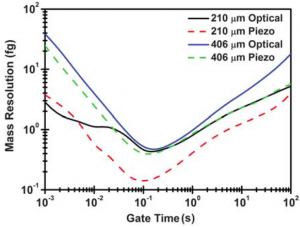Suspended Microchannel Resonators with Piezoresistive Sensors
- Category: MEMS & BioMEMS
- Tags: Scott Manalis
Precision frequency detection has enabled the suspended microchannel resonator (SMR) to weigh single living cells, single nanoparticles, and adsorbed protein layers in fluid. To date, the SMR resonance frequency has been determined optically, which requires the use of an external laser and photodiode and cannot be easily arrayed for multiplexed measurements. Here we demonstrate the first electronic detection of SMR resonance frequency by fabricating piezoresistive sensors using ion implantation into single crystal silicon resonators [1] . To validate the piezoresistive SMR, buoyant mass histograms of budding yeast cells and a mixture of 1.6-, 2.0-, 2.5-, and 3.0-mm-diameter polystyrene beads are measured. Figure 1 shows our experimental setup. For piezoresistive detection, a Wheatstone bridge is built with the piezoresistor and three external resistors. The bias voltage (5 V) is selected to maximize the signal while limiting the temperature increase in the piezoresistor due to resistive heating. Figure 6 shows mass resolution derived from mass sensitivity and Allan variance. In summary, the mass resolution achieved with piezoresistive detection is comparable to what can be achieved by the conventional optical-lever detector in 1 kHz bandwidth. Eliminating the need for expensive and delicate optical components will enable new uses for the SMR in both multiplexed and field deployable applications.
- Figure 1: Experimental setup for optical-lever and piezoresistive detection methods and interface to downstream electronics. The dynamic displacement of the SMR is measured with either the laser/photo-detector or the on-chip piezoresistor, amplified, phase-shifted, and fed back to a piezocrystal actuator. The resonance frequency is down-mixed to 1–2 kHz and recorded.
- Figure 2: Mass resolution derived from sensitivity calibration and measured Allan variance of the SMR resonance frequency of SMRs as a function of the gate time, which is an averaging window for Allan variance calculation. Raw data were measured at a sampling rate of 1 kHz for 1 hour.
- J. Lee, R. Chunara, W. Shen, K. Payer, K. Babcock, T. Burg, and S. R. Manalis, “Suspended microchannel resonators with piezoresistive sensors,” Lab on a Chip, vol. 11, no. 4, pp. 645-651, Feb. 2011. [↩]

